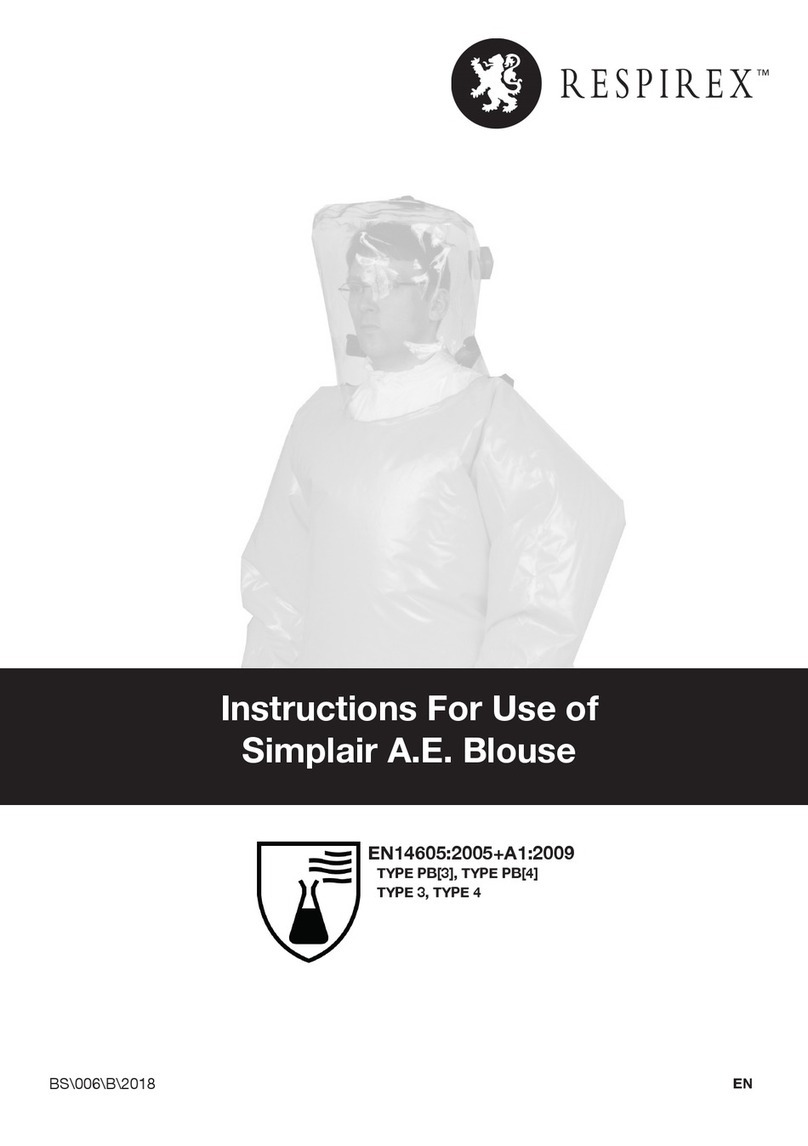
General Information
The Respirex GLS 300 A is a one-piece single use chemical protective gas tight suit that is CE marked to indicate
compliance with the basic safety requirements under article 10 and 11B of the European PPE Directive 89/686/
EEC and the DEKRA Standard FRM 90.166.0. The DEKRA Standard FRM 90.166.0 species the performance
requirements for the materials of construction (e.g. abrasion resistance, tear resistance etc.), and for the suit as
a whole (e.g. resistance to penetration by liquids, resistance to outward leakage of gases etc.).
Respirex GLS 300 A chemical protective gas tight suits are manufactured from a high performance barrier
laminate material engineered for use in chemical protective clothing. The combination of the barrier laminate
and the polymer provide a particle-tight material with good resistance to penetration and permeation by many
liquids and gases.
The barrier laminate oers protection in a wide range of applications including:
• Chemical handling
• Hazardous waste clean-up
• Paint spraying
• Pharmaceutical manufacturing and / or packaging
• Disease and disaster management
• Emergency response services, spill clean-up and accident interventions
Typical garment features include:
• A large semi-rigid visor bonded to the suit that provides the wearer with an excellent eld of vision
• A 112 cm (44”) rubber/ textile combination Gas Tight Nylon zip tted to the rear of the garment with an
overap sealed by Velcro®.
• Integral bootees (sock like extension of the suit leg that encapsulates the entire foot) intended to be worn
inside separate (i.e. not attached) protective ESD safety boots that provide protection against mechanical
risks.
• Outer legs (splash guards) intended to prevent liquid entering the safety boots
• KCL Butoject gloves complying with EN374-1:2003, EN388:2003 & EN420:2003 permanently attached to
the suit (for data specic to the use of KCL Butoject gloves please refer to the user information supplied).
• Two exhalation valves are tted to the rear of the suit which automatically releases any excess pressure
which builds up inside the garment during use.
The suit MUST be worn in combination with self contained open-circuit compressed air breathing apparatus
(SCBA) conforming to EN 137 and facemask conforming to EN 136.
Warnings & Limitations
• Before selecting appropriate protective clothing a detailed assessment of the nature of the hazard
and the working environment should be undertaken. There are dierent factors such as concentration,
temperature, pressure and other environmental inuences, that have signicant inuence on the barrier
properties of GLS 300 A suits.
• Only for use by trained competent personnel.
• Exposure to certain very ne particles, intensive liquid sprays and splashes of hazardous substances may
require protective clothing of higher mechanical strength and barrier properties than those oered by the
GLS 300 A suit.
• The suit is designed for SINGLE USE only, Respirex cannot guarantee the integrity or performance
characteristics of a suit that has seen multiple cycles of usage.
• Stored in its normal packaging the GLS 300 A suit has a maximum shelf-life of 5 years.
• GLS 300 A suits should not be used in environments where there is a high risk of puncture occurring.
• If the suit is heavily contaminated or mechanically damaged in any way it MUST NOT be used and MUST
be disposed of.
• Never modify or alter this product.
• Please ensure that you have chosen suitable PPE for your application. The user shall be the sole judge for
the correct combination of full body protective coverall and ancillary equipment (gloves, boots, respiratory
equipment etc) and how long a GLS 300 A suit can be worn on a specic application with respect to its
protective performance, wear comfort or heat stress.
1





























